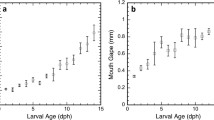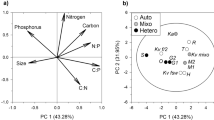Abstract
The mechanisms underlying differential prey selection of two microcrustaceans by the common bladderwort (Utricularia vulgaris) were studied in the laboratory. Functional response experiments with single prey showed that Utricularia had a higher attack rate coefficient and a longer handling time coefficient with the cladoceran Polyphemus pediculus than with the cyclopoid copepod Eucyclops serrulatus. Observation of predation rate, defined as number of prey eaten per unit time, from direct behavioural observation on single prey species, showed a higher predation rate with Polyphemus than on Eucyclops, at low prey densities. The opposite pattern was found at high prey density. When the two prey were presented simultaneously to the predator, Eucyclops was preferred over Polyphemus. Results from the situation with two prey and some of the results from the direct behavioural observations support field data on the diet of Utricularia, which shows that cyclopoid copepods are selected more frequently than Polyphemus.
Similar content being viewed by others
References
Akre, B. G. & D. M. Johnson, 1979. Switching and sigmoid functional response curves by damselfly naiads with alternative prey available. J. anim. Ecol. 48: 703–720.
Andrikovics, S., L. Forro & E. Zsunics, 1988. The zoogenic food composition of Utricularia vulgaris in the Lake Ferto. Opusc. Zool. Budapest 23: 65–70.
Butorina, L. G., 1986. On the problem of aggregations of planktonic crustaceans (Polyphemus pediculus (L.), Cladocera). Arch. Hydrobiol. 105(3): 355–386.
Chesson, J., 1983. The estimation and analysis of preference and its relationship to foraging models. Ecology 64: 1297–1304.
Colton, T. F., 1987. Extending functional response models to include a second prey type: an experimental test. Ecology 68: 900–912.
Folt, C. L. & P. C. Schulze, 1993. Spatial patchiness, individual performance and predator impacts. Oikos 68: 560–566.
Harms, S., 1999 Prey selection in three species of the carnivorous aquatic plant Utricularia (bladderwort). Arch. Hydrobiol. 146(4): 449–470.
Holling, C. S., 1959. Some characteristics of simple types of predation and parasitism. Can. Entomol. 91: 385–398.
Holt, R. D., 1977. Predation, apparent competition and the structure of prey communities. Theor. Pop. Biol. 12: 197–229.
Huang, C. & A. Sih, 1990. Experimental studies on behaviourally mediated, indirect interactions through a shared predator. Ecology 71: 1515–1522.
Johansson, F., 1995. Increased prey vulnerability as a result of preyprey interactions. Hydrobiologia 308: 131–137.
Juniper, B. E., R. J. Robins & D. M. Joel, 1989. The Carnivorous Plants. Academic Press, London.
Lawton, J. H., J. R. Beddington & R. Bonser, 1974. Switching in invertebrate predators. In Usher, M. B. & M. H. Williamson (eds), Ecological Stability. Chapman and Hall Ltd: 141–158.
McNeely, D. L., B. N. Futrell & A. Sih, 1990. An experimental study on the effects of crayfish on the predator-prey interactions between bass and sculpin. Oecologia 85: 69–73.
Murdoch, W. W. & A. Oaten, 1975. Predation and population stability. Adv. Ecol. Res. 9: 2–131.
Paine, R. T., 1966. Food web complexity and species diversity. Am. Nat. 100: 65–75.
Reynolds, J. G. & M. C. Geddes, 1984. Functional response analysis of size-selective predation by the notonectid predator Anisops deani (Brooks) on Daphnia thomsoni (Sars). Aust. J. mar. Freshwat. Res. 35: 725–733.
Sih, A. & R. D. Moore, 1990. Interacting effects of predator and prey behaviour in determining diets. In Hughes, R. N. (eds), Behavioural Mechanisms of Food Selection. Springer-Verlag, Berlin. 771–796.
Smyly, W. J. P., 1957. Distribution and seasonal abundance of Entomostraca in moorland ponds near Windermere. Hydrobiologia 11: 59–72.
Spitze, K., 1985. Functional response of an ambush predator: Chaoborus americanus predation on Daphnia pulex. Ecology 66: 938–949.
Straškraba, M., 1965. Contributions to the productivity of the littoral region of pools and ponds. I. Quantitative study of the littoral zooplankton of the rich vegetation of the backwater Labícko. Hydrobiologia (Haag) 26: 421–443.
Systat., 1992. Systat for windows: statistics, Version 5 edition. Evanston, IL: SYSTAT, Inc., 1992: 750 pp.
Werner, E. E., 1992. Individual behaviour and higher order species interactions. Am. Nat. 140: 5–32.
Wootton, J. T., 1993. Indirect effects and habitat use in an intertidal community: interaction chains and interaction modifications. Am. Nat. 141: 71–89.
Zaret, T. M., 1980. Predation and Freshwater Communities. New Haven, Conn., Yale University Press.
Author information
Authors and Affiliations
Rights and permissions
About this article
Cite this article
Harms, S., Johansson, F. The influence of prey behaviour on prey selection of the carnivorous plant Utricularia vulgaris. Hydrobiologia 427, 113–120 (2000). https://doi.org/10.1023/A:1003961614595
Issue Date:
DOI: https://doi.org/10.1023/A:1003961614595




